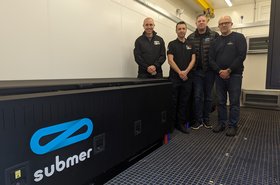As the pressure to deliver a more sustainable world grows, data center operators must continue to drive down their carbon footprint, which is now estimated to be larger than the airline industry. Advancements in optical technology have enabled significant improvements in data center interconnect (DCI) network speed, capacity, and reach in recent years, inching toward terabits per wavelength networking. However, these technologies alone are not enough — operators need to consider how to scale networks more efficiently.
As we look forward to tomorrow's DCI networks, the focus is on technologies that will allow even faster speeds, greater reach, and improved performance. The core challenge, however, is how to optimize all of these capabilities while simultaneously reducing cost per bit per kilometer and increasing sustainability. Which next-generation optical network technologies will enable DCI network operators to achieve this goal of a more green data center network?
Network transformation
It goes without saying that today’s hyperscalers face enormous pressure to match escalating data capacity demands. In fact, analyst firm IDC predicts that data will continue growing at an annual growth rate of roughly 21 percent to exceed 221 Zettabytes by 2026. This data explosion is not expected to slow down anytime soon, thanks to the demand for over-the-top (OTT) services, the proliferation of the Internet of Things (IoT) connectivity, and the confluence of cloud computing, big data analytics, and artificial intelligence (AI) technologies.
These trends, in turn, are fueling the growth of the DCI networks that are critical to linking traffic between massive hyperscale data centers around the world. More importantly, this growth is leading to increased challenges related to scalability, distance, latency, and sustainability that are driving a transformation in the architecture, design, and operation of these networks.
Strengthen sustainability
Despite the demand for more storage and compute power, many data center operators are faced with ongoing space and budget constraints. As a result, network systems are being concentrated into an ever-smaller footprint, increasing thermal load on networking equipment. And as thermal load increases, data center networks require much greater cooling resources.
This transformation creates a constant need for decreased energy consumption and reduced heat transfer inside the data center, and to a lesser extent across DCI networks as well. Network operators require a new design approach to reduce power consumption, and the urgency of this need is further compounded by rising energy costs and global initiatives like the UN’s Race to Zero Campaign.
With the traditional approach of air cooling, today’s data centers and DCI network central offices (COs) require larger fans running at increasingly higher speeds to handle heat generation. This not only creates deafening noise, it also consumes excessive energy. It’s now estimated that the worldwide energy consumption of data centers will reach 803 Terawatt Hours by the year 2027.
In the world of supercomputers, the intense thermal load can generate heat density exceeding 100 kilowatts per square meter. Advanced liquid cooling technology, which was developed to deal with this supercomputer thermal challenge, is being applied to next-generation DCI transport network architecture to significantly lower operating temperatures and cut acoustic noise in half.
Closed-loop liquid cooling technology improves DCI network sustainability in several ways. First, liquid cooling provides far better heat transfer to maintain a lower operating temperature. Plus, because the system itself consumes less energy, power consumption can be reduced by more than 40 percent, and finally, fans run much slower in a liquid-cooled system, enabling longer fan life for higher reliability, smaller carbon footprint, and reduced maintenance.
Boost scale and performance
In spite of the race to greater sustainability, the demand for more data speed and bandwidth is still driving the need for increased DCI network performance, capacity, and scalability. In order to meet these demands while maintaining competitiveness, hyperscalers must cut costs and streamline operational efficiency, even as they enhance capacity.
Traditionally, the wavelength range of ROADM networks was limited because conventional transmission solutions were divided into C-band and L-band. This is particularly problematic in metro and long-haul DCI networks. Recent advances in continuous C+L ROADM architecture allow transport platforms to handle both wavelength bands at once. This not only increases maximum transmission capacity and simplifies network capacity upgrades, it also reduces environmental impact by using half the common line system equipment versus current bolt-on or C-band overbuild approaches.
In addition to capacity enhancements, technology advances are contributing to increased distance for long-haul DCI networks. With Raman amplification, network operators can build out ROADM architecture with a cleaner overall signal and longer reach. Yet, Raman amplification to date has been limited to backward-facing configurations where the amplifier is on the receiving end of the fiber span only. Next-generation forward Raman technology allows amplification on both ends of the link, enabling an increase in either reach or capacity up to 40 percent.
Automate operations
The task of maintaining a live optical network used to be a manual, time-intensive, full-time job. However, with an increasingly lean operations staff to manage the end-to-end network, many network operators are turning to increased use of automation and AI to perform simple tasks in a safe and reliable way. This not only frees up experienced technicians for more important activities, but it also decreases the risk of human error and lowers costs.
Performance of the typical ROADM network will vary as a function of fiber type and active optical channel counts. With a mix of fiber types in the fiber plant, extensive testing and comprehensive record-keeping are needed to ensure correct amplifier biasing and wavelength optimization. By leveraging AI-enabled automation, the fiber plant can be quickly characterized to determine fiber type, span loss, and latency for zero-touch turn-up and optimization, decreasing human error and simplifying operations while also reducing carbon footprint.
Lighting the way to tomorrow
As today’s data centers progress toward the terabit era, data center operators and hyperscalers are continually pressured to handle the exponential growth in network traffic even as they reduce cost per bit. This digital evolution is driving enormous change in DCI network architecture, spawning next-generation technologies like liquid cooling, continuous C+L band operation, forward Raman, and AI/ML-enabled automation. Together these optical network advancements will help DCI network operators meet the challenges of exceedingly fast speeds, expanding global reach and exponential growth while supporting greater sustainability for the future.








